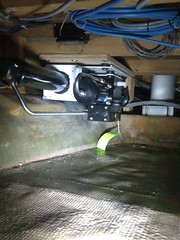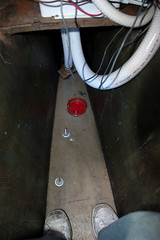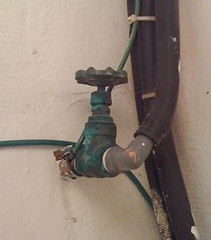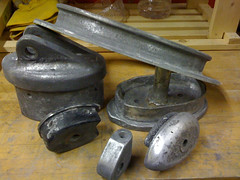
Last night after about 2.5 hours in the sewer I finished mounting the
Spectra Capehorn Extreme
membrane and clark pump unit. The unit is mounted on a piece of 3/4"
marine grade plywood with 1/4"-20 machine screws and tee-nuts on the
back, or in this case the top of the board. I took the unit into the
sewer and propped it up on tupperware containers to get it roughly into
place. As I laid on my side in the sewer I marked the final location.
The board itself is mounted to two cross-beams supporting the salon
floor. I originally had planned to mark the location, pull the unit out,
remove the board, then mount the board alone and then screw the unit
back to the board. As I had everything in place, I realized getting to
the machine screws was going to be a lot harder than getting to the lag
bolts so I decided to mount it en masse, with the unit attached to the
board.
Putting in the aft bolts (the ones you see in the pic) was fairly easy
as the sewer is deep and there is a decent amount of room between the
rear edge of the watermaker and the refrigerator compressor which sits
aft (and out of frame) of the watermaker. Because the sewer is not as
deep as you go forward and the mast and maststep impede access, the
forward lag bolts are not as easy to reach. Given the impinged space I
was only able to get 5 bolts into the board. The forward outer most
corner is not bolted. However, the frame of the unit is wedged between
the joists and the hull so it's not going anywhere and there is not room
for it to wiggle.
I have some concerns that the fact the unit is wedged will cause a lot
of noise to be transferred to the boat, but I won't know about that
until we turn it on. If it needs to be moved I think the only option
will be to angle it more or to find a completely different location.
Hopefully it will be fine where it is.
This project isn't done yet, but this was a big step. The membrane is
about 40" long and it either takes up an entire settee or the entire
workbench in the aft cabin, so just getting it out of the way makes the
boat tremendously more pleasurable to liveaboard especially since the
other settee is covered with the contents of the hanging locker where
all the pumps and controls for the watermaker are installed.
Next steps are to finish all the plumbing and then setup a test run with
Emerald Harbor Marine who will
come out and look things over before we power it on for the first time.
Sooo clooooose to done... ;-)





